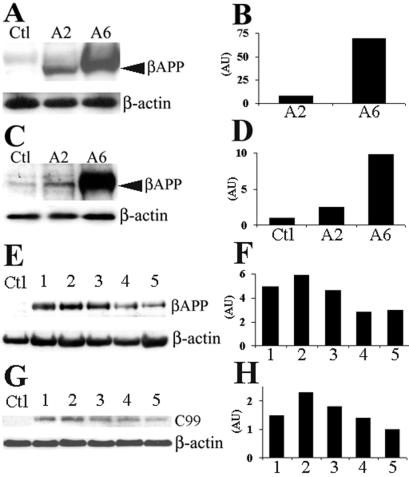Figure 2.
Immunoblot analysis of βAPP and carboxy-terminal fragments in skeletal muscle. Protein extracts from skeletal muscle were prepared from age-matched transgenic mice from the A2 and A6 lines along with a nontransgenic littermate. Both transgenic lines clearly show accumulation of the human βAPP protein (indicated by the arrowhead) whereas, as expected, no signal was detected in nontransgenic control littermates (referred to as Ctl) when immunoprobed with 6E10 (A). To compare transgene-derived βAPP levels with endogenous mouse βApp, skeletal muscle extracts were prepared and immunoprobed with 22C11, which labels both murine and human βAPP (designated by the arrowhead) (C). Skeletal muscle from A6 transgenic mice was immunoprobed with human-specific 6E10 to determine the steady-states levels of transgene-derived βAPP as a function of age (E). Representative immunoblot using 6E10 that shows steady-state levels of the C99 fragment of βAPP on skeletal muscle extracts from adult A6 transgenic mice of varying ages is shown (G). Both βAPP and C99 show fairly stable steady-state levels of the transgene product with a modest decline with advanced age. For E–H, lane Ctl = nontransgenic, lane 1 = 4–6 mo, lane 2 = 9–11 mo, lane 3 = 14–16, lane 4 = 19–21 mo, and lane 5 = 24–26; n = 4–5 mice per each time point. Densitometric analysis of band intensities after normalization to β-actin for each corresponding blot are shown in B, D, F, and H.

